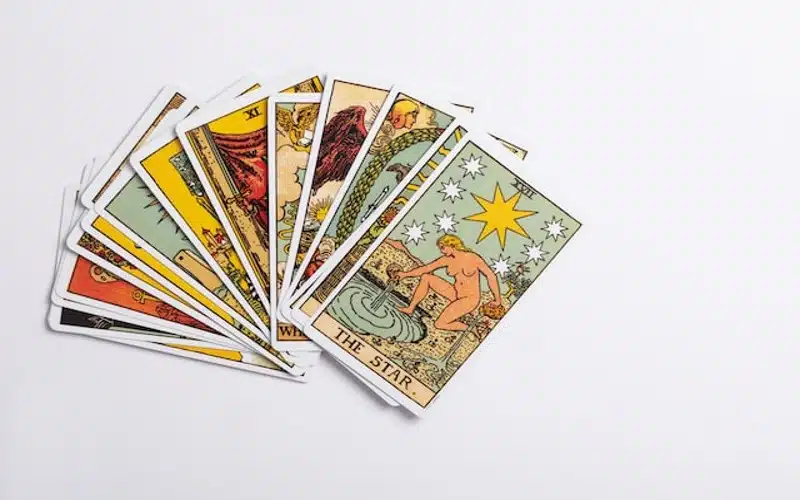The Hierophant is the keeper of tradition. As such, the fifth tarot card of the Major Arcana represents the wisdom of past generations, including practices that helped societies grapple with life’s mysteries. This card follows the nurturing Empress and protective Emperor, two archetypes in the Major Arcana sequence that form the foundation for the Hierophant’s work.
Tradition keeps the intentions of our ancestors alive. Perhaps they hoped for the health and prosperity of the future, and the institutions that we preserve promote that desire. However, we know that not everything is right simply because it’s old. For instance, the practice of oppressing people has also been passed down from generation to generation.
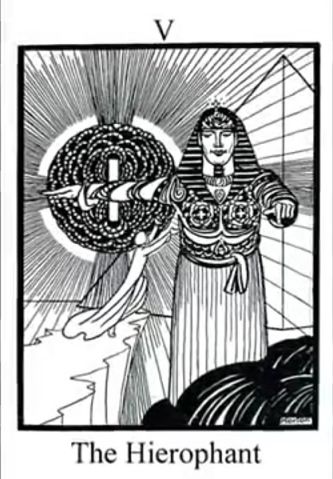
Therefore, like all cards in the tarot deck, the Hierophant has a multi-faceted meaning. When this tarot card appears, you’re called to learn about or examine traditions. Which inherited beliefs sustain your well-being, and which ones would you like to release?
Keywords
The upright Hierophant might mean that the following factors are important in a reading:
- Traditional values
- Cultural institutions
- Religious education
- Social pressure
- Gatekeeping
The reversed Hierophant, by contrast, usually shows what challenges or compromises cultural traditions. This might involve the following interpretations:
- Nonconformity
- Liberation
- Open-mindedness
- Self-trust
- Corruption
Whether upright or reversed, the Hierophant always points to the institutions that shape us: churches, schools, teams, corporations, and so on. The upright card often indicates the power that these institutions have over our minds, for better or for worse. The reversed card, on the other hand, tends to show us how traditions might erode.
General Associations
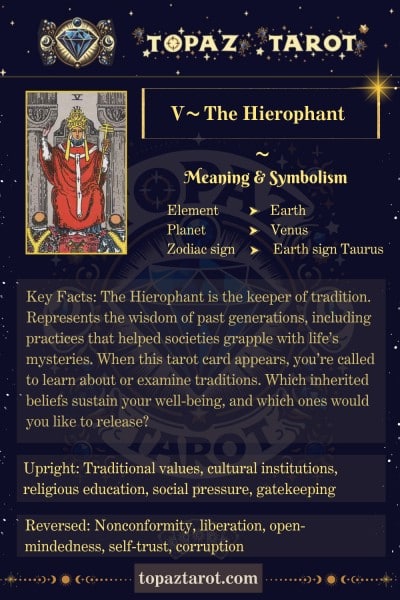
In general, the Hierophant’s symbols emphasize the structured and well-established nature of this individual’s role. At the same time, the number five carries the significance of transition: wherever there’s tradition, there must also be space for adaptation.
| Number | Five (5), meaning change |
| Element | Earth |
| Planet | Venus |
| Zodiac Sign | Earth sign Taurus |
Description of the Card
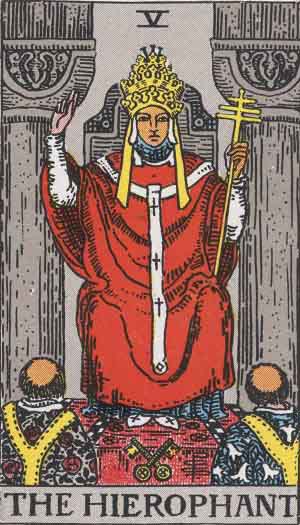
In the Rider-Waite-Colman tarot deck, the Hierophant resembles the High Priestess. Both of these figures wear robes and crowns, sit between two pillars, and have objects at their feet. In fact, the icons on both of these cards illustrate spiritual wisdom. And yet, the High Priestess and the Hierophant have two very different roles in society.
You can think of the Hierophant as the authority on widely accepted spiritual traditions—the card was originally known as “the Pope,” after all. For instance, the Hierophant represents the influence of dominant religions while the High Priestess presides over what society considers the deviant sets of spiritual practices. (Santería, paganism, mysticism, and Satanism are all examples of such practices.)
When you examine the Hierophant tarot card, consider how the symbols convey both divine mystery and earthly power:
- Right hand: The figure’s hand makes the shape of a divine blessing, which the Hierophant has the power to bestow.
- Triple cross: This is a Christian emblem for the Pope.
- Red robe: Though the Hierophant’s principles are often strict, the red reminds us that these principles came to exist in order to sustain life and vitality.
- Triple crown: Again, the triple crown connects this individual to the Pope’s divine authority.
- Two pillars: One pillar generally represents doctrine and the other disobedience. Because the Hierophant sits between them, together the pillars point to the wisdom of a balanced approach in our interpretations of spiritual mysteries.
- Keys: Possibly the keys to the kingdom of heaven, each contains symbols of the four elements.
- Worshippers: The authority of this figure gathers followers who uphold tradition.
Meaning of the Hierophant
If you were like me when I received my first tarot deck, you might be wondering, “What on Earth is a hierophant, anyway?” The esoteric name made this card seem mysterious and inaccessible—words that accurately describe the Hierophant, funnily enough.
A hierophant was an interpreter of mysteries, often a priest, in ancient Greece. A fellow named Antoine Court de Gébelin renamed this card in the 18th century to separate it from papal associations and Christian iconography overall. As global society becomes more secular, the Hierophant card has also come to represent all social groups that form our worldviews. For instance, the Hierophant could indicate family, school, or government instead.
When you contemplate the Hierophant, consider how social groups, values, and standards are affecting you now. When do you identify with those around you, and when do you feel at odds? Do your relationships with certain groups make you feel good or otherwise?
Upright Interpretation
It might seem silly, but the Hierophant always makes me think of teen movies. In these films, there’s often a plot arc that focuses on an “innocent” character learning how social dynamics work at school. For instance, in Mean Girls, Cady Heron first learns where every group sits in the cafeteria and eventually becomes “queen bee” of the Plastics. In Clueless, popular Cher gives the new student Tai a makeover.
Movies about youth often radiate Hierophant energy because characters must choose to conform with groups or individuate from them. In fact, most plots focus on this exact personal development, with the main character coming to understand that they want to freely express who they are.
When you receive the Hierophant upright, a social institution or tradition is key. Examples might include the following:
- Marriage
- Family of origin or extended family
- Business affiliation
- Work promotion or role
- Church or mission
- Community service organization (shelter, food bank, etc.)
- School or university
- Political affiliation
- Legal system
- Retirement community
- LGBTQ+ community
Truly, any group or practice within your social networks might be relevant when you receive the Hierophant. Specific values within these systems also matter. Perhaps our family expects certain gender roles, but we don’t identify with our assigned gender expectations. On the other hand, we choose political groups because we share the same ideas about autonomy, collective responsibility, and justice.
Because we don’t fit in with every aspect of the society we inherit, sometimes this card carries the weight of social pressure. You might fear the consequences of being different. The Hierophant could also represent a “gatekeeper,” a powerful individual in your community who denies other people access to certain rights or privileges.
Reversal Interpretation
To me, the reversed Hierophant speaks to one of three general meanings. First, this tarot card shows that a person is liberated from the pressures around them. This could look like radiant self-expression or active resistance. However, a person might simply learn how to be more open-minded and fluid with beliefs, introducing more possibility into their community.
Most accepted spiritual leaders were first nonconformists, so deviating from tradition is itself an important social tradition! Apart from religious dissent, the reversed Hierophant could signal alternative lifestyles, such as polyamory, homeschooling, or living in a commune.
Second, this card is about trusting yourself as much as more than the authorities around you. Although you can learn much from your elders, there comes a time when you need to insert your own needs and desires into the equation. What can you bring to the table that the people before you could not?
Finally, the reversed Hierophant sometimes indicates the reason why dissent helps us survive: corruption of our institutions. You can think of many examples in which leaders proclaim to act on behalf of collectives but instead serve only themselves. Politicians and religious leaders, for instance, often abuse their powers. When it becomes clear that an entire system is flawed, defying or departing from it is often necessary.
Meaning in Specific Readings
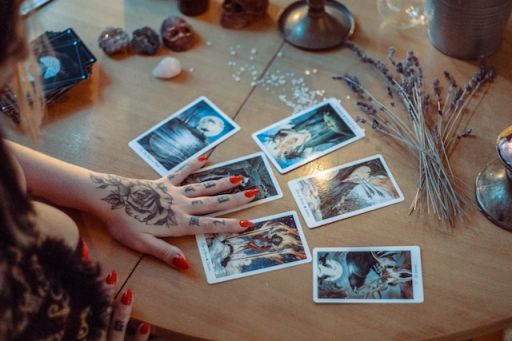
You likely read the Hierophant a little differently for different situations. In the summaries below, you can explore how to interpret this tarot card in readings that address yes-no questions, love life, and work.
Yes-No Meaning
The Hierophant is a more neutral card than most. When it appears for a yes-no reading, the answer is “maybe.”
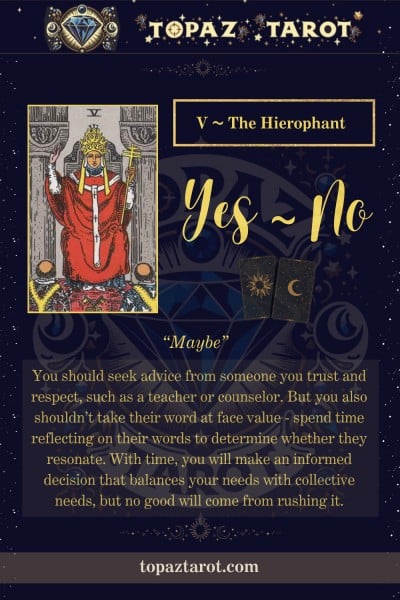
You should seek advice from someone you trust and respect, such as a teacher or counselor. But you also shouldn’t take their word at face value—spend time reflecting on their words to determine whether they resonate. With time, you will make an informed decision that balances your needs with collective needs, but no good will come from rushing it.
Meaning for Love
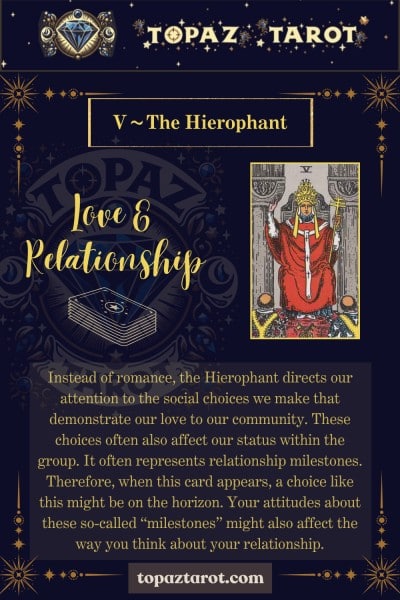
Instead of romance, the Hierophant directs our attention to the social choices we make that demonstrate our love to our community. These choices often also affect our status within the group.
For instance, the Hierophant often represents relationship milestones: engagement, marriage, sharing property, having children, co-parenting, and writing a will are all examples. Therefore, when this card appears, a choice like this might be on the horizon. Your attitudes about these so-called “milestones” might also affect the way you think about your relationship.
Meaning for Work
When the Hierophant tarot card appears in a work reading, the team dynamic or hierarchy is key. For example, you might be adjusting to a new role or training a new team member. A promotion might also be in your future.
At these times of transition, be thoughtful about how you present information and include the people around you. Now might be a time to change the way your team has “always done things.” But often you just need to model the tried-and-true methods clearly and effectively.
Key Card Combinations
As usual, you might perceive different meanings in the card pairings below. However, I’ve provided some suggestions to illustrate how certain tarot cards might interact with the Hierophant. I hope you’ll use these to inspire your own interpretations.
Major Arcana
| Major Arcana Card | Meaning with the Hierophant |
| 0. Fool | The circumstances involve students or a school environment. |
| I. Magician | There’s a maverick in your group or possibly a cult of personality. You might choose to follow this person or resist their influence. |
| VI. Lovers | You’re making or considering a commitment. |
| XII. Hanged Man | You have doubts about the path you’ve chosen. |
| XVI. Tower | Corruption is likely. |
| XVIII. Moon | Some facts are currently concealed. Avoid making decisions until the truth is evident. |
| XX. Judgment | A legal outcome is imminent. For instance, this pairing could represent a literal judge reading a sentence. |
Minor Arcana
The Hierophant always amplifies the number five in the Minor Arcana. This tarot also combines with various other Minor Arcana cards to add nuance to an interpretation.
| Minor Arcana Card | Meaning with the Hierophant |
| Ace of Wands | You experience a spiritual revelation. |
| Four of Wands | A ceremony, such as a wedding or graduation, is the setting. |
| Four of Cups | A retreat from society could be useful now. |
| Six of Cups | A family decision or parenting is the focus. |
| Eight of Cups | Leaving a church or other organization is necessary. |
| Eight of Swords | You’re experiencing persecution. |
| Nine of Swords | Seek help from others during a crisis of faith. |
| Three of Pentacles | Your work with a community organization is a factor. |
| Five of Pentacles | Exile or banishment is a theme. |
| Six of Pentacles | A charity organization might be relevant. |
| Seven of Pentacles | You’re reconsidering the role of work in your life. |
| Ten of Pentacles | You must execute a will. |
| Queens and Kings of any suit | The Hierophant magnifies the importance of gender roles and expectations when it appears with these higher court cards. |
Frequently Asked Questions (FAQs)
Review answers to specific questions about the fifth tarot card of the Major Arcana.
When the Hierophant tarot card appears, social traditions and institutions are the focus of the reading. The customs are often religious, but not always.
An individual who embodies the Hierophant card is highly educated and holds authority within an organization. They’re highly respected and others might seek guidance from them. A Hierophant type likely provides conventional solutions that have stood the test of time.
In a yes-no reading, the Hierophant means “maybe.” Seek advice from trusted guides and meditate on your own needs before making a decision.
Negative aspects of the Hierophant include social pressure, gatekeeping, and institutional corruption.
The Hierophant represents the earth sign Taurus.
Learn the Tarot with Online Flash Cards
Are you looking to dive into the world of tarot and master the meaning of each card? You should check out our post, “Learn The Tarot Cards – Online Flash Cards” by our own Tarot expert Ersa Fay. With interactive flash cards covering all 78 cards in the tarot, both the Minor and Major Arcana, you will learn key facts and the symbolism and meanings associated with each card.
By using these flash cards, you’ll become more comfortable with performing your own readings and enhance your journey into the world of tarot.
In the post, Ersa focuses on the iconic Rider-Waite-Smith tarot deck, known for its rich imagery and profound symbolism. The captivating illustrations in this deck draw from various sources such as mythology, astrology, alchemy, and the Kabbalah, creating a visual language that resonates deeply with the human psyche. So, if you’re ready to start learning, don’t miss out on this fantastic resource. We hope you find it useful and remember to have fun with it!

